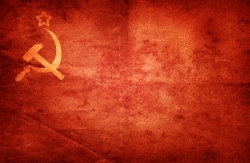 USSR is the acronym for Union of Soviet Socialist Republics, created in 1922 by the leader of the Bolshevik Revolution, Lenin. Was a federation of several republics led by Russia, initially bringing together Ukraine, Armenia, Georgia, Azerbaijan, establishing for the first time in history a socialist regime.
USSR is the acronym for Union of Soviet Socialist Republics, created in 1922 by the leader of the Bolshevik Revolution, Lenin. Was a federation of several republics led by Russia, initially bringing together Ukraine, Armenia, Georgia, Azerbaijan, establishing for the first time in history a socialist regime.
The Union of Soviet Socialist Republics or Soviet Union was a communist experiment, which it lasted 74 years, where Russian revolutionaries Vladimir Lenin and Leon Trotsky were the main characters. The system was imploded in 1991 by the destructive forces of its own contradictions.
In the first decade of the 20th century, Russia was still a feudal state. Tsar Nicholas II ruled like an autocratic monarch. At that time, Russia began a rapid process of industrialization. The lives of 15 million workers were hard. Working conditions in the factories were precarious, favoring the emergence of radical and revolutionary parties. In 1898 the Russian Social Democratic Party, which was based on Marx's ideas, was founded. In 1903 the party was divided into Menshevik and Bolshevik. Strikes and demonstrations were carried out against the imperialist regime.
In 1917 the Revolution broke out, the Bolshevik Party, supported by the soviets and the working and peasant mass, under the leadership of Lenin, occupied the streets of St. Petersburg and ended up seizing power, which was handed over to the Council of People's Commissars, led by Lenin In 1922, the Union of Soviet Socialist Republics was formally created.
USSR and socialism
In 1917, Lenin was the great architect of the Russian Revolution, his power rested on the soviets, on the Red Army (created by Trotsky to defend the revolution), in the political police, the Cheka, and in the Bolshevik Party which was transformed into the Communist Party in 1918.
The Russian population began to integrate into politics through the trade unions and the Communist Party. An active minority made up the Party, which had an organization similar to that of the soviets: a congress, a central committee and a political directory. The new regime faced four years of civil war against white Russians, adherents of the old regime, backed by European countries fearful that socialism would spread. In 1922, a new constitution created the Union of Soviet Socialist Republics (USSR).
After Lenin's death in 1924, a power struggle broke out in Russia between Trotsky and Stalin. For Trotsky, the uncompromising Marxist, Russian armies should immediately propagate the Communist revolution throughout the world. For Stalin, socialism should first establish itself in Russia and only from there spread to other countries. Defeated Trotsky was expelled from the country.
In 1941, the USSR was already composed of several nations of different ethnicities and cultures, the bloc was formed by Russia, Ukraine, Belarus, Latvia, Estonia, Lithuania, Moldova, Georgia, Armenia, Azerbaijan, Turkmenistan, Kazakhstan, Tajikistan, Kyrgyzstan and Uzbekistan. With Stalin in power for 25 years, the USSR knew one of the bloodiest and cruelest dictatorships in history.
USSR in World War II
The USSR was part of World War II history thanks to Operation Barbarossa (or Operation Redbeard), a military offensive by the German military army led by Adolf Hitler. Germany's invasion of the USSR began on June 22, 1941 and was successful at first, but the USSR resisted and gained some victories in important battles in 1942 and 1943.
At the end of World War II, the USSR conquered a vast territory of Europe, thus consolidating its position as a military superpower.
USSR and the Cold War
The Cold War (an undeclared war) was the period of conflicts and hostilities between the USSR (leader of the socialist bloc) and USA (leader of the capitalist bloc). The destruction and geopolitical weakening of the great European capitalist powers after World War II, added to the advance of socialism, made possible the division of the world into two emerging and ideologically antagonistic superpowers: USA and USSR.
Learn more about Cold War.
USSR and CIS
The state socialism of the USSR had already been showing signs of economic wear and tear since 1980. Bureaucratic structures, excessive state control, one-party rule, and ruling class privileges nullified the individual liberties of ordinary citizens. Several protests and protests created the conditions for the structural changes that began to take place in most socialist countries.
The Commonwealth of Independent States (CIS) was formalized on December 8, 1991, with the presence of the presidents of Russia, Ukraine and the Belarus, replacing the Soviet Union, for the purpose of economic partnership and defense of its members.
Currently the CIS members are: Armenia Azerbaijan, Belarus, Kazakhstan, Moldova, Russia, Tajikistan, Turkmenistan, Ukraine and Uzbekistan.
